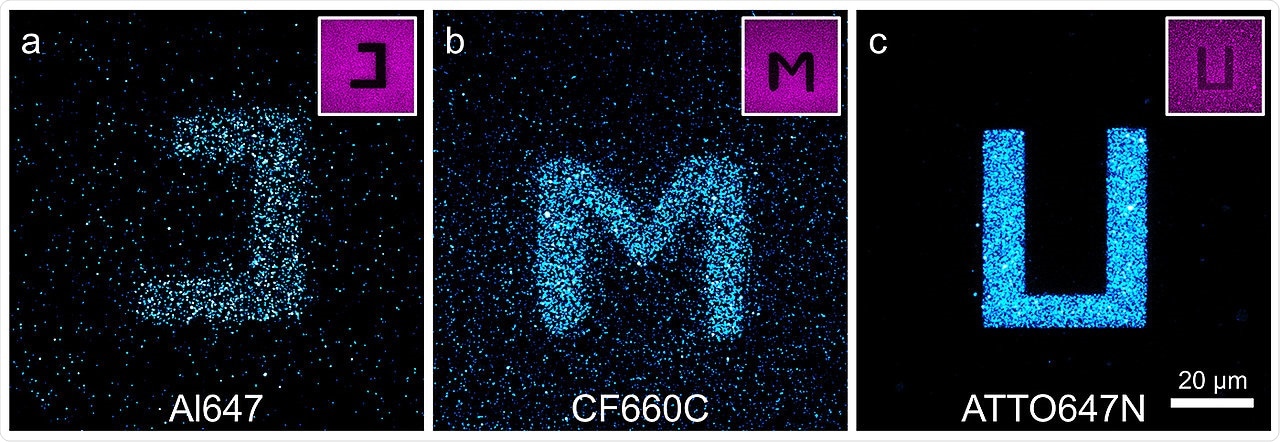The new advances in fluorescence microscopy make it viable to image molecular complexes or individual molecules in cells with a spatial resolution of up to 20 nm.

Confocal fluorescence images of glass surfaces coated with the cyanine dyes Alexa Fluor 647 (a) and CF660C (b) and with carborhodamine dye ATTO647N, (c) after light excitation at 568 nanometers (nm). By exciting the red-absorbing dyes at 640 nm in certain areas (negative images top right), dyes are photoconverted there and it is possible to write letters on the surface that were excited at 568 nm and fluoresce at about 580 nm. The carborhodamine dye shows more efficient photobluing than the cyanine dyes. Image Credit: Team Markus Sauer/University of Würzburg.
But under certain conditions, an effect takes place that fabricates the results—the laser light utilized can cause highly reactive oxygen molecules to develop in the specimen. These molecules can subsequently affect the fluorescent dyes used to such a degree that they stop fluorescing. This effect is called photobleaching among microscopy experts.
But numerous fluorescent dyes can also be converted by photobleaching such that they absorb shorter-wavelength light.
A previously red fluorescent dye then glows green. Its fluorescence has been shifted towards the blue range on the wavelength scale. This is why this effect is called photoblueing.”
Markus Sauer, Professor and Expert, Super-Resolution Microscopy, Biocentre of Julius-Maximilians-Universität Würzburg
The first exact description of photoblueing
For the first time, Sauer’s research team has now presented the precise molecular process of photoblueing for cyanine dyes, such as Cy5, in the Nature Methods journal. The publication also involved Dr. Martin Schnermann from the Centre for Cancer Research in Frederick (USA).
Because we understood the mechanism so precisely, we were able to prevent photoblueing by simple additives such as vitamin C or to increase it by adding a kind of catalyst.”
Markus Sauer, Professor and Expert, Super-Resolution Microscopy, Biocentre of Julius-Maximilians-Universität Würzburg
Inhibiting photoblueing can be very critical. While the effect can only influence a few percent of the dye utilized, it can still lead to misinterpretation or errors of the microscopy, for instance, n energy transfer experiments (FRET). This is because the transformed dyes are identified with the same level of high sensitivity as the preliminary products.
Simple buffers prevent photoblueing
Our results show which dyes are affected and how photoblueing can be prevented by simple buffer additions. But they equally show how photoblueing can possibly be used advantageously for fluorescence imaging and for tracking single, specifically converted dye molecules.”
Markus Sauer, Professor and Expert, Super-Resolution Microscopy, Biocentre of Julius-Maximilians-Universität Würzburg
That is precisely what Sauer’s research team hopes to do next—photoblueing is to be further designed for, among other things, the selective monitoring of individual viral and bacterial particles in infection processes.
Source:
Journal reference:
Helmerich, D. A., et al. (2021) Photoblueing of organic dyes can cause artifacts in super-resolution microscopy. Nature Methods. doi.org/10.1038/s41592-021-01061-2.